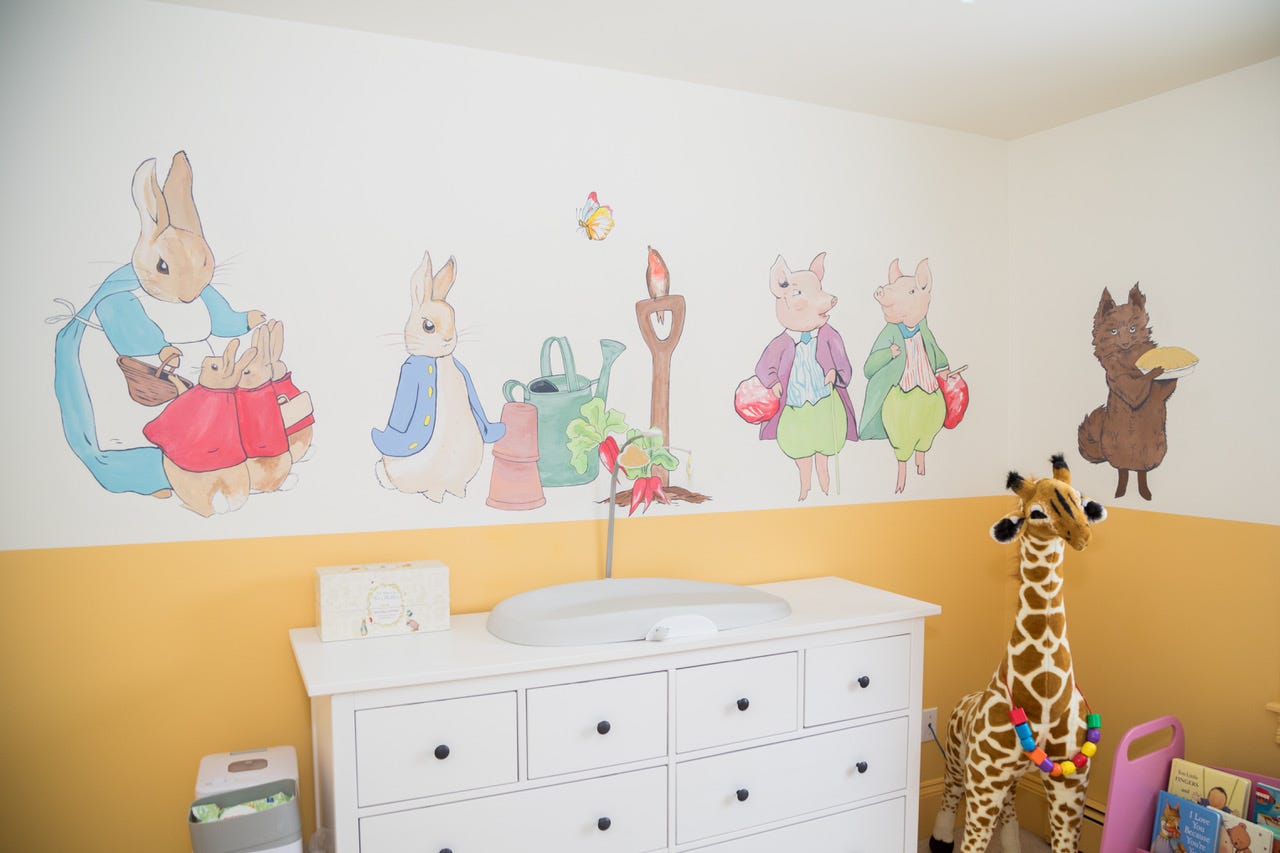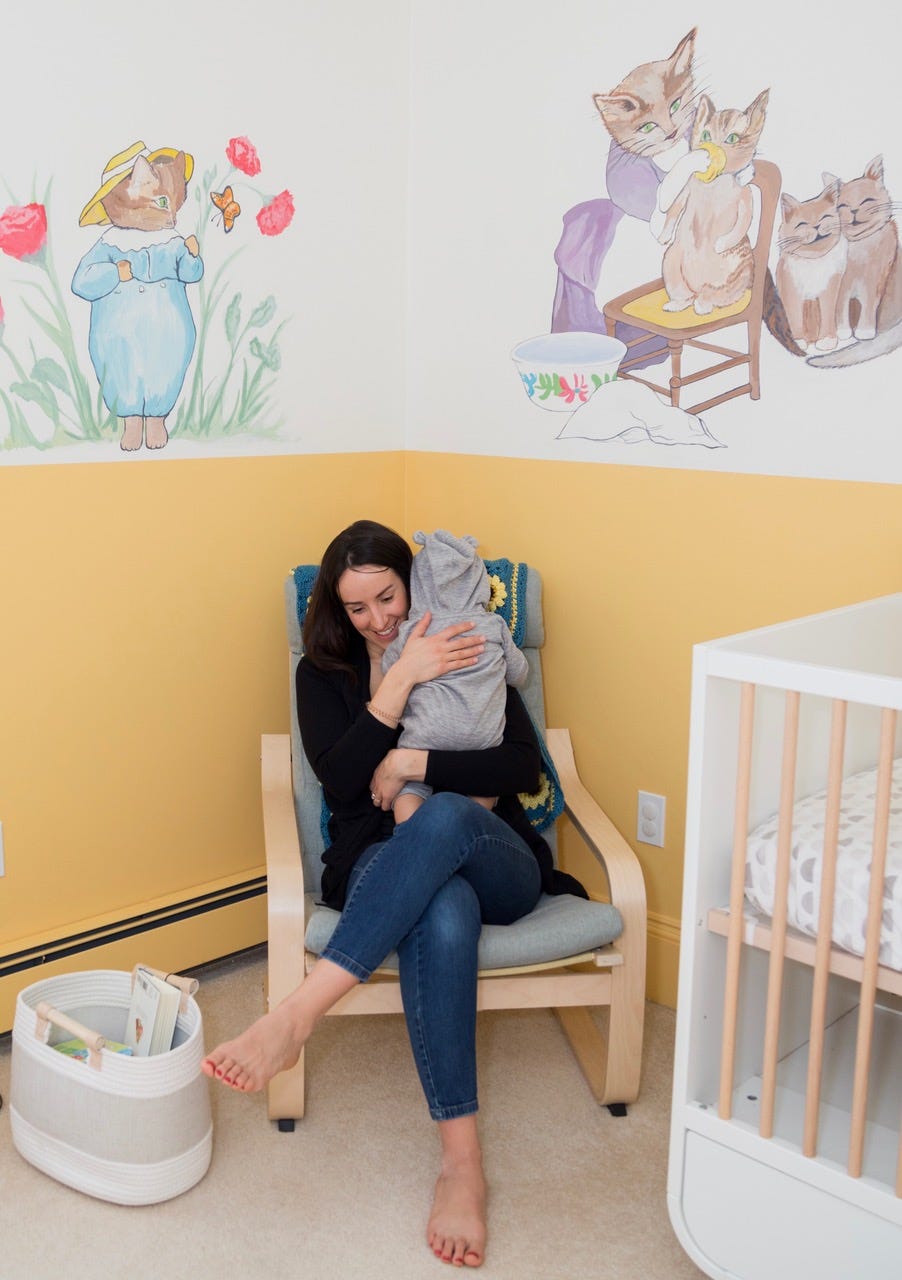How Painting a Mural for My Baby’s Early Life Made Me a Better Doctor for Patients at the End of Theirs
How art has transformed me as a mother and a hospice physician

I glide the bristles along the wall, leaving a flash of coral pink against the bare white background. The painted foxgloves are blossoming on my soon-to-be-born daughter’s nursery wall, alongside favorite characters from Beatrix Potter’s timeless story-tales: Jemima Puddle-Duck in her blue bonnet, Peter Rabbit among the radishes in Mr. McGregor’s garden, and pudgy Tom Kitten scrunched into his ill-fitting romper. I smile, the absurdity of cute animals in formalwear making these scenes from my own childhood reading endlessly endearing.
The stark contrast of these playful images in comparison to my serious role as a hospice doctor, caring for people at the end of their lives, isn’t lost on me— especially, while surrounded by death, I am simultaneously preparing, at nine months pregnant, to bring new life into the world.
My phone’s ringing startles me from my reverie. It’s the hospice nurse, calling to update me about our patient Dorothy*, a retired schoolteacher in her sixties with metastatic cancer. I had admitted Dorothy to hospice days earlier after she’d made the decision to stop chemotherapy and focus entirely on managing symptoms and feeling as comfortable as possible for the time she had remaining, knowing she would likely die within days to weeks.
Earlier that morning, Dorothy had been restless, thrashing around in bed, unable to get comfortable. So, with Dorothy’s consent and her family’s support, I adjusted her medications to ease her discomfort while accepting she would be slightly more sedated.
The first time I met with Dorothy, only forty-eight hours earlier, she had told me about her career as a high school English teacher and how she’d had a lifelong love of literature. We’d chatted about some of our favorite novels, and when I asked what the best part of her job had been, she’d said it was sharing her love of books with students, showing them how reading had the power to transport them to other worlds and make everything else fade away.

Looking around at my baby’s nursery, I’m reminded of how painting murals has given me this same gift Dorothy described: when I’m painting, all the noise, anxieties, and stresses of work and daily life fade into the background until they are imperceptible. I enter a state of flow while making my brushstrokes along the wall, and in playing with color I get in touch with a real sense of joy and lightheartedness I remember from childhood: from the days of running around outside, before the drudgery of bills, deadlines, and other realities of adulthood presented themselves. It’s not an exaggeration to say there’s a magic I find in painting that prevents me from focusing on the dark thoughts that can creep in after being exposed to death so repeatedly in my work.
The next day, Dorothy is much more comfortable, lying peacefully while her family, sitting around her bed, share stories and play her favorite music (classical piano) in the background, knowing her death is near. Seeing them engaging with music in her company and honoring her in this thoughtful way shows me they understand the power of the arts to comfort us in moments of pain and unite us in times of uncertainty.
As a hospice physician, I guide very sick people and their loved ones through the process of death. We talk about how it’s normal for a dying person to stop feeling hunger and thirst, and I acknowledge how difficult this can be for a family to accept, in our culture that often equates providing nourishment with expressing love. We talk about what death can physically look like, from the mottling hues on the skin to the gurgling sounds of breathing in the final stages. I ask patients and families what they are worried about; many people have never seen a person die, after all, and often have preconceived images in their minds based on what they’ve seen in the media. The question I’m asked most often is how much time I think someone has left (something that no doctor ever knows with absolute certainty, by the way), which tells me that we all get at least a little uncomfortable with the uncertainty of what lies ahead.
When I started working in a hospice, I never imagined being on the receiving end of so many hugs and thank-yous. People who have never set foot in a hospice often assume it’s thankless, depressing work, but those who have been close to death get a sense of the true privilege of it. There is no greater honor than supporting people in their most vulnerable moments. I’m continually amazed by how much gratitude is sent my way, often simply for being there for the patient and family in these challenging times, not even for my medical expertise, per se.
And yet, even amid all the expressions of gratitude, there’s a toll that comes from being so close to death. There’s no longer a day that goes by where I don’t think about my own death, or that of my loved ones, and feel all too aware that no day alive is guaranteed. As time has gone on, this has weighed on me more, especially after caring for patients who were dying far too young, and seeing the unimaginable grief enveloping their families. I started coming home and bringing with me remnants of the distress and grief I’d spent my day at work surrounded by, and began to feel it darken my thoughts and mental state, even though I loved seeing my young son when I got home, and was excited to welcome his baby sister into the world.
As my daughter’s due date neared, I knew I needed a shift in my mindset. I wanted to improve my spirits, to ensure her entry into the world would be safe and joyful, with a mother who was as healthy, happy, and grounded as I could manage to be. So, during my pregnancy with her, I began to paint. I painted murals for friends’ nurseries to begin, and then I joyously set out painting one for my own daughter’s room.
At work, when there were particularly hard moments, I noticed I felt comforted by the knowledge that I could spend some time by myself painting later that day. I knew this would help energize me after a heavy day’s work. Opening up the cans of paint and seeing the images come to life on the walls before me brought a lightness and delight back to my mood and my days. This lightness affected not only my mental state as I prepared for my baby’s arrival, it also positively impacted my interactions with patients. I still felt saddened to see people dying and suffering with grief—this will never change, nor would I want it to—but getting in touch with a creative outlet that helped me feel alive and joyful spurred my curiosity about my patients’ lives and joys, not just their illnesses and endings. Though my job is to guide patients through their deaths, connecting with this feeling of liveliness through painting has made me more curious about what has brought them joy, comfort, and meaning throughout their lives. This has deepened my interactions and connections with them as a result.
Painting helped heal my mind and restored me to a place of mental strength and resilience in my work and in my preparation for months of sleepless nights with a newborn, and the many joys and challenges this beautiful season of life entails.
Getting to know people at the end of their lives is the most powerful reminder that we all have a finite time to live. Learning about their passions and finding out what animates them has been a gift that’s helped me be better at my job. Reconnecting with my creative side through painting helped remind me of the things that matter most to me in my own life: my relationships with those closest to me, and doing what makes me feel alive and joyful, like spending time outdoors in nature, and painting. Each brushstroke brings with it a deeper mindfulness to my work as a physician, and a greater, more positive presence as a mother.
My daughter is now nearly a year old, and though it’s not easy to make the time, I continue to paint (often squeezed in during her naps, after bedtime, or if I can secure a babysitter for a few hours) as she navigates these early days of her life. Painting continues to brighten my mood and strengthen my resilience in navigating the challenges of motherhood, while preparing me for my return to work supporting patients in the final days of their beautiful, complicated lives.
*Note: The patient Dorothy is based on multiple patient stories. Name and identifying information have been changed to preserve patient confidentiality.
Laura Schep’s writing has appeared in The Globe and Mail, Business Insider, The New York Times’ Tiny Love Stories, and the Canadian Family Physician. She lives in the beautiful Annapolis Valley region of Nova Scotia, Canada, where she works as a physician in acute care and hospice.




Love your art and the point you made about creativity. I'm much happier when I have a creative outlet.
Having a creative outlet is crucial to a healthy life! Kudos to you for finding yours! And even more, for the work you do helping people!!
Thank you for your lovely story. The mural is darling.